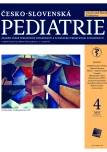Gregor Mendel celebrates 200 years: from the gardens of the Augustinian monastery in Brno to the causal treatment of monogenic diseases
Authors:
Slabý Ondřej 1,2; Dostál Ondřej 1; Slabá Kateřina 3
Authors‘ workplace:
Biologický ústav, Lékařská fakulta, Masarykova univerzita, Brno
1; Ústav patologie, FN Brno
2; Pediatrická klinika, FN Brno
3
Published in:
Čes-slov Pediat 2022; 77 (4): 189-197.
Category:
Comprehensive Report
doi:
https://doi.org/10.55095/CSPediatrie2022/031
Overview
This year we celebrate the 200th anniversary of Gregor Mendel’s birth. Mendel was not recognized for his scientific work during his lifetime. It was not until 16 long years after his death that his work was rediscovered to lay the foundations for a new field – genetics. Mendel›s contribution lay not only in his own experiments and their results, but above all in the methodological innovation that consisted in the use of mathematics and statistics in biological research, which was something completely new for the then purely descriptive biological sciences. Interestingly, Mendel’s motivation was not to expand human knowledge. Mendel, as he himself stated in the introduction to his work, was interested in the principles of heredity so that he could breed better and better ornamental plants. This desire for improvement was also reflected in his other research activities in the field of beekeeping or meteorology. Although he never had a university degree, Mendel was a very popular teacher. He was the head of one of the largest and richest monasteries in Moravia. His life and work, his followers and the builders of his legacy, the history of medical genetics in our country, as well as the contributions of Mendelian genetics to modern medicine are discussed in our review.
Keywords:
Gregor Mendel – life – scientific work – followers – medical genetics
Sources
1. Dostál O. Gregor Johann Mendel – člověk, opat a vědec. Brno: Masarykova univerzita a Mendelovo muzeum 2011.
2. Laudátová H, Dostál O. Gregor Johann Mendel – životní osudy a jeho působení na Moravě. Živa 2012; 6: 266–268.
3. Šmarda J. Johann Gregor Mendel – výjimečný člověk a geniální vědec. Universitas 2012; 2: 2–10.
4. Iltis H, Paul E, Paul C. Life of Mendel. New York: W. W. Norton & Company 1932.
5. Orel V. Gregor Mendel a počátky genetiky. Praha: Academia 2003.
6. Klein J, Klein N, Klein P. Solitude of a Humble Genius – Gregor Johann Mendel: Volume 1. New York: Springer 2013.
7. Kuciel J, Urban T. Principy genetiky. Brno: Mendelova univerzita v Brně 2016.
8. Mukherjee S. Gen: o dědičnosti v našich osudech. Překlad Jan Šmarda. Brno: Masarykova univerzita 2019.
9. Snustad PD, Simmons MJ. Genetika. 2. vyd. Brno: Masarykova univerzita 2017.
10. Mendel G. Versuche über Pflanzen-Hybriden. Verhandlungen des naturvoschenden Vereines in Brünn. 1866: Abhandlungen 3–47.
11. Petr J. Osobnost: Hrách mu vydal velké tajemství. Lidové noviny, 18. 7. 2015.
12. Corcos A, Monaghan F. Role of de Vries in the recovery of Mendel’s work. I. Was de Vries really an independent discoverer of Mendel? J Hered 1985; 76: 187–90.
13. Gayon J. From Mendel to epigenetics: History of genetics. C R Biol 2016; 339: 225–30.
14. Radick G. Mendel the fraud? A social history of truth in genetics. Stud Hist Philos Sci 2022; 93: 39–46.
15. Fisher RA. Has Mendel’s work been rediscovered? Ann Sci 1936; 1: 115– 137.
16. Novitski E. On Fisher’s criticism of Mendel’s results with the garden pea. Genetics 2004; 166: 1133–1136.
17. Goetz P. Historie lékařské genetiky v České republice. Čas Lék Čes 2006; 145: 88–92.
18. Slabý O, et al. Molekulární medicína. Praha: Galén 2015.
19. Scott AF, Amberger JS. The genes of OMIM: A legacy of Victor McKusick. Am J Med Genet A 2021; 185: 3276–3283.
20. Ferrua F, Aiuti A. Twenty-five years of gene therapy for ADA-SCID: from bubble babies to an approved drug. Hum Gene Ther. 2017; 28: 972– 981.
Labels
Neonatology Paediatrics General practitioner for children and adolescentsArticle was published in
Czech-Slovak Pediatrics

2022 Issue 4
Most read in this issue
- Sepsis in children
- Differential diagnosis of microscopic hematuria
- Dystrophinopathies
- Hyperthermia, its causes and risks from the pathophysiologist’s perspective
